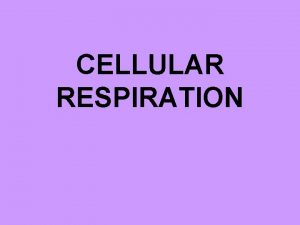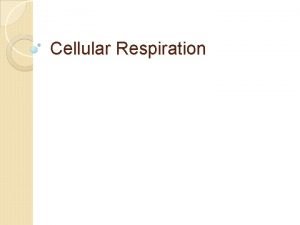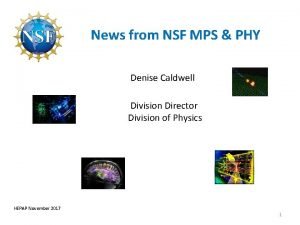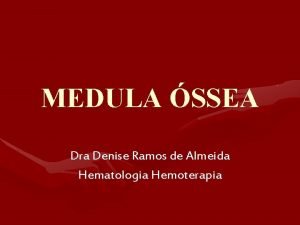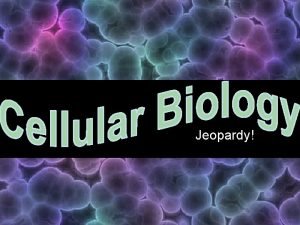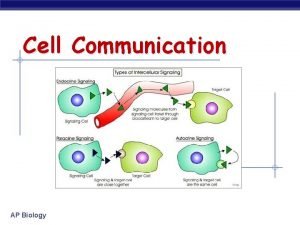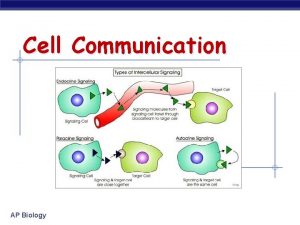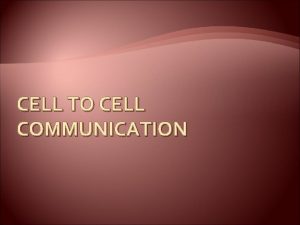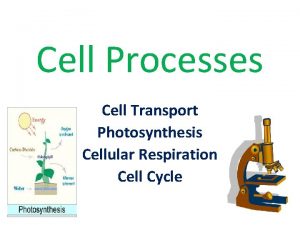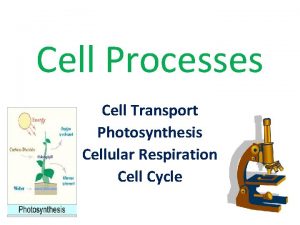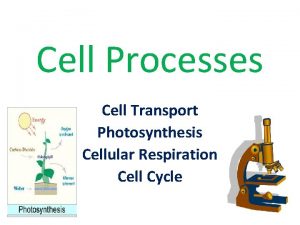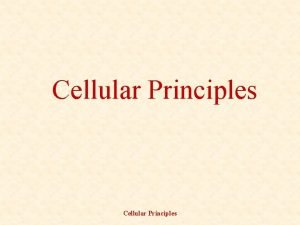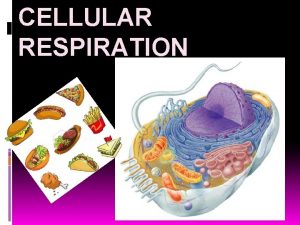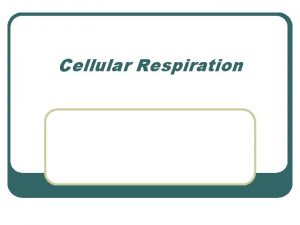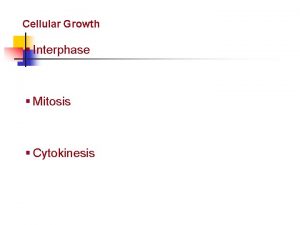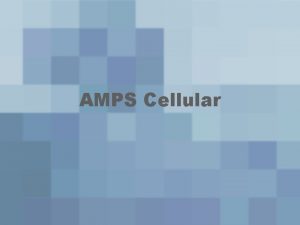Cellular Communication Denise Green The first cell communication






























- Slides: 30

Cellular Communication Denise Green

The first cell communication to be discovered was between two mating types of yeast cells.

Communication can occur through junctions through which chemical signals that are dissolved in the cytosol can move. Cells can recognize each other through cell surface molecules

Some chemicals signal nearby target cells. This is know as paracrine signaling or synaptic signaling.

Local regulators affect neighboring target cells. ØGrowth factors are peptides and proteins that stimulate cell proliferation ØNitric oxide functions as a neurotransmitter v. Secreted by white blood cells it kills bacteria and certain cance cells v. Released by endothelial cells it relaxes smooth muscles in blood vessel walls causing dilation ØProstaglandins (PGs) v. Help induce childbirth, fever and inflammation

Hormones are used in plants and animals for long distance signaling. In animals, this is called endocine signaling.

The three stage of cellular signaling: Reception, Transduction, and Response. l http: //media. pearsoncmg. com/bc/bc_campbell_biology_7/media/interactivemedia/activities/load. html? 11&A

Signal Transduction Pathway l The process by which a signal received on a cell’s surface is converted into particular cellular response.

A signal molecule, a ligand, binds to a receptor protein in a lock and key fashion, causing the receptor to change shape. Most receptor proteins are in the cell membrane but some are inside the cell. The G-protein is a common membrane receptor.

There are three most common types of membrane receptor proteins. l G-protein coupled receptors l Receptor tyrosine-kinases l Ion channel receptors

G-Protein Coupled Receptors are often involved in diseases such as bacterial infections.

Receptor Tyrosine kinases catalyze the transfer of phosphate groups to initiate cell response.

Ligand-Gated Ion Channel Receptors contain a region that can act as a “gate” when the receptor changes shape. Ligand gated channels are very important in the nervous systemneurotransmitters. Voltage-gated ion channels are crucial to functioning of nervous system.

Intracellular signaling includes hormones that are hydrophobic and can cross the cell membrane. Once inside the cell, the hormone attaches to a protein that takes it into the nucleus where transcription can be stimulated. Testosterone acts as a transcription factor.

The transduction stage of signaling is often a multistep process that amplifies the signal. About 2% of our genes are thought to code for kinases. http: //media. pearsoncmg. com/bc /bc_campbell_biology_7/media/in teractivemedia/activities/load. ht ml? 11&C

Small molecules and ions act as secondary messengers.

Response- cell signaling leads to regulation of transcription or cytoplasmic activities.

Apoptosis, programmed cell death, integrates multiple cell-signaling pathways. l Paw development and digit development requires apoptosis.

Invertebrates have a variety of hormones for signaling ØRegulation of water balance ØIn hydra- regulation of growth and budding ØSpecialized neurons control egg laying in mollusks and reduce feeding and locomotion ØArthropod molting is hormonally controlled by an enzyme called ecdysone ØIn insects, control is by brain hormone (BH): Juvenile hormone (JH) controls BH and ecdysone

Hormonal regulation of insect development

Two systems control all physiological processes 1. Nervous System – neurosecretory glands in endocrine tissues secrete hormones. 2. Endocrine System

Human Endocrine System

Major Vertebrate Endocrine Glands Their Hormones (Hypothalamus–Parathyroid glands)


Two regulatory systems of humans work together ØNervous system ØEndocrine system

Neurosecretory cells in endocrine organs and tissues secrete hormones. These hormones are excreted into the circulatory system.

Stress and the Adrenal Gland

Figure 45. 4 One chemical signal, different effects


http: //vcell. ndsu. nodak. edu/animations/regulatedsecre tion/movie. htm
 Yellow light
Yellow light Cellular transport and the cell cycle
Cellular transport and the cell cycle All cells must contain
All cells must contain Where in the cell does cellular respiration occur
Where in the cell does cellular respiration occur Where in the cell does cellular respiration occur
Where in the cell does cellular respiration occur Denise yaghmourian gallery phoenix
Denise yaghmourian gallery phoenix Denise lord
Denise lord Jacqui saburido
Jacqui saburido Denise schout
Denise schout Denise gabuzda
Denise gabuzda Dr denise wood
Dr denise wood Denise farrelly
Denise farrelly Denise trimble
Denise trimble Weeds denise
Weeds denise Denise hayward
Denise hayward Daniel ansorge
Daniel ansorge What is the theme of the weary blues
What is the theme of the weary blues Denise kerrigan
Denise kerrigan Denise camp
Denise camp Denise caldwell nsf
Denise caldwell nsf Denise andersson hagfors
Denise andersson hagfors Dra denise hematologista
Dra denise hematologista Denise johnson case
Denise johnson case Sound energy pictures
Sound energy pictures Denise coffey death
Denise coffey death Business ed with denise leigh
Business ed with denise leigh Denise keaton
Denise keaton Denise shannon
Denise shannon Denise hollowell
Denise hollowell Denise luther
Denise luther Denise brandon
Denise brandon


